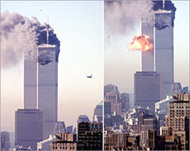WTC report finds fault in fireproofing
A US investigation on the collapse of World Trade Centre buildings in the 11 September 2001 attacks has concluded that a fault in fireproofing may have led to the collapse of the twin towers.

Federal investigators have said in their reports that the collapse would have been avoided if fireproofing had adhered firmly to the columns and floors.
“Even with the airplane impact and jet-fuel-ignited multi-floor fires, which are not normal building fires, the buildings would likely not have collapsed had it not been for the fireproofing that had been dislodged,” said The National Institute of Standards and Technology (NIST) in its three reports on the attacks.
Shyam Sunder, who led NIST’s fire and safety investigation, said on Tuesday that there are now better ways to ensure that fireproofing adheres to steel.
The reports also found that in Tower 1, it took the average survivor 48 seconds to descend a flight of stairs. This was double the slowest evacuation time estimated in a current fire safety handbook used by engineers who design buildings, the reports said.
 |
|
Fireproofing could have saved the twin |
The NIST concluded that better communication between emergency responders could have saved more lives.
The NIST found that the much-documented problems with radio communication and information-sharing among first responders probably “contributed to the loss of emergency responder lives.”
The findings represent the NIST’s last step before issuing its final recommendations in June, the culmination of exhaustive research and testing that produced 10,000 pages of data.
The official World Trade Centre toll stands at 2749, including those killed on the two jetliners that hijackers crashed into the buildings.